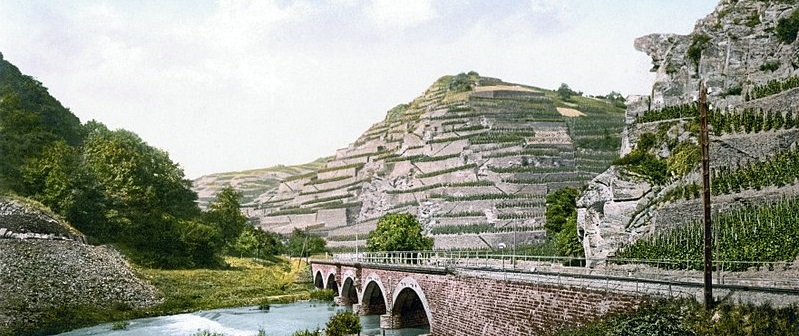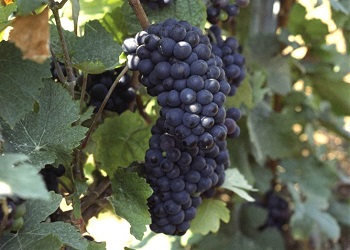German Wine

Spätburgunder (Pinot Noir) Müller Thurgau Grauburgunder Dornfelder Weissburgunder Silvaner Chardonnay Portugieser Kerner Trollinger
Source: Deutsches Weininstitut GmbH 2023
Planting by Type
Germany is well known for its high-quality white wines, particularly Riesling.
The German wine production is focused on white wines (Riesling and Müller-Thurgau), but there are also significant plantings of red wine grapes such as Spätburgunder (Pinot Noir).

Source: Deutscher Wein Statistik 2021 / 2022
Major German Grapes
German Wine Regions
Germany has several distinct wine regions, and each region has its unique terroir, unique grapes and unique winemaking traditions, contributing to the rich German wine culture.
| Region | Hectares |
|---|---|
| Rheinhessen | 27 300 |
| Pfalz / Palatinate | 23 500 |
| Baden | 16 000 |
| Württemberg | 11 500 |
| Mosel | 9 000 |
| Franken | 6 000 |
| Nahe | 4 000 |
| Rheingau | 3 000 |
| Saale-Unstrut | 850 |
| Ahr | 600 |
| Sachsen | 500 |
| Mittel-Rhein | 500 |

Mosel (9 000 ha)

A steep vineyard overlooking Zell at the Mosel River
The Mosel River in western Germany, is probably the most famos of the German wine districts.
It is famous for its steep vineyard slopes, slate soils, and for fine Rieslings with delicate floral aromas, vibrant acidity, and pronounced minerality.
Mosel also produces some exceptional sweet wines, including the Mosel Riesling Auslese, Beerenauslese, and Trockenbeerenauslese, which are made from grapes affected by noble rot (Botrytis cinerea).
Most important grapes 2022:
- Riesling (62%)
- Müller-Thurgau (9%)
- Elbling (5%)
- Spätburgunder (6%)
Source: Statistisches Bundesamt (Stand 27.02.2023) © Deutsches Weininstitut GmbH
Rheinhessen (27 300 hectares)
Rheinhessen is the larges wine region in Germany. It is located on the west cost of the Rhine River between Nahe and Pfalz.
The region is known for its fertile soils, steep slopes, and diverse grape varieties.
The most famous production area is the steep vineyards (the Rheinterrasse) by the village of Nierstein where they produce some of the fullest bodied Rieslings in the world.
While Riesling is important in Rheinhessen, the region has gained recognition for its innovative winemaking and experimentation with international grape varieties such as and Grauburgunder (Pinot Gris), Weissburgunder (Pinot Blanc), Spätburgunder (Pinot Noir) and Chardonnay.
Most important grapes 2022:
- Riesling (19%)
- Müller-Thurgau (14%)
- Dorfelder (11%)
- Grauburgunder (9%)
- Silvaner (7%)
- Weissburgunder (6%)
- Spätburgunder (6%)
- Chardonnay (4%)
Source: Statistisches Bundesamt (Stand 27.02.2023) © Deutsches Weininstitut GmbH
Rheingau (3 000 ha)

Vineyards in Rheingau on the Rüdesheimer Berg, seen from Rheinhessen on the opposite side of the Rhine.
Rheingau is located along the Rhine River north of Reinhessen (see the picture above).
The most important vineyards are located on the slopes by the villages Johannisberg and Rüdesheim.
Rheingau is one of Germany's smallest wine regions, but it is known for producing some of the country's most prestigious Riesling wines.
Rheingau Rieslings, with flavors of ripe stone fruit, citrus, and honey, are fuller-bodied and often more expensive compared to those from other regions.
The region is also renowned for its historic vineyard sites, including the famous Rüdesheimer Berg and Johannisberg.
Reingau also produces fine cool-climate Spätburgunder (Pinot Noir).
Most important grapes 2022:
- Riesling (77%)
- Spätburgunder (24%)
Source: Statistisches Bundesamt (Stand 27.02.2023) © Deutsches Weininstitut GmbH
Spätlese - Noble Rot

Schloss Johannisberg is one of the best known historical domaines in Germany.
It is famous as an early adopter of the Riesling grape and where the first German noble rot was discovered by accident.
There is a popular story that the Riesling producers at Schloss Johannisberg in Rheingau in 1775 awaited the order from the estate owner, Bishop of Fulda, before cutting the grapes.
But the abbey messenger was robbed en route, and the cutting was delayed for three weeks, time enough for the botrytis (noble rot) to take hold.
The grapes were presumed worthless but given to locals who produced a surprisingly good sweet wine which became known as Spätlese (late harvest wine).
In the following years, several different classes were introduced, and Spätlese was further elaborated, first into Auslese in 1787 and later into Eiswein in 1858.
Pfalz / Palatinate (23 500 ha)
Pfaltz is Germany's second largest wine region.

The VDP.GROSSE LAGE® FELSENBERG in the Felsenberg-Berntal nature reserve.
These vines are planted on a south slope, on a rock band of limestone, 220 metres above sea level with 25% gradient.
Pfalz is located in southwestern Germany along the Rhine River, north of Alsace (France), and the vineyards are practically a continuation of the Alsatian vineyards.
Pfalz is known for its warm and sunny climate which is conducive to ripening a wide range of grape varieties.
Some of the best Rieslings in the world comes from Pfalz.
While Riesling is the most important grape, the region also produces excellent Müller-Thurgau, Dornfelder, Grauburgunder (Pinot Gris), Pinot Noir (Spätburgunder) and Weissburgunder (Pinot Blanc).
Pfalz wines are known for their richness, fruitiness, and deep flavors.
Most important grapes 2022:
- Riesling (25%)
- Dornfelder (11%)
- Grauburgunder (9%)
- Spätburgunder (7%)
- Müller-Thurgau (7%)
- Weissburgunder (6%)
- Portugieser (5%)
Source: Statistisches Bundesamt (Stand 27.02.2023) © Deutsches Weininstitut GmbH

Weinberge in der Pfalz (Vineyards in the Palatinate).
Nahe (4 000 ha)

Vineyards in Nahe
Nahe is located south of the Rhein, west of Rheinhessen.
The dominating production is a typical Riesling with high acidity and citrus aromas.
Most important grapes 2022:
- Riesling (29%)
- Müller-Thurgau (11%)
- Grauburgunder (9%)
- Dornfelder (9%)
- Weissburgunder (8%)
- Spätburgunder (7%)
Source: Statistisches Bundesamt (Stand 27.02.2023) © Deutsches Weininstitut GmbH
Baden (16 000 ha)
Baden is located south in Gemany, close to the French border. It is Germany's third-largest wine region and one of the warmest.
The region produces a diverse range of wines, including Pinot Noir (Spätburgunder), Müller-Thurgau, Pinot Gris (Grauburgunder) and Pinot Blanc (Weissburgunder).
The Pinot Noir wines are well balanced and the Pinot Gris and Pinot Blanc wines are often oaked.
Most important grapes 2022:
- Spätburgunder (33%)
- Grauburgunder (15%)
- Müller-Thurgau (14%)
- Weissburgunder (10%)
- Riesling (6%)
Source: Statistisches Bundesamt (Stand 27.02.2023) © Deutsches Weininstitut GmbH
Württemberg (11 500 ha)
Württemberg is large wine region, but unlike other German regions, Württemberg focuses much on red wine production, producing cool-climat red wines like Blaufränkisch (Lemberger), Trollinger (Schiava), Spätburgunder (Pinot Noir) and Schwarzriesling (Pinot Meunier).
Most of the wine produced in the region is consumed locally.
Most important grapes 2022:
- Riesling (19%)
- Trollinger (17%)
- Blaufrankisch (16%)
- Spätburgunder (12%)
- Schwarzriesling (11%)
Franken / Franconia (6 000 ha)
Franken is located in Bavaria, east from the better known Rhein regions.
 |
 |
 |
 |
Franken is known for the Bocksbeutel bottle, and its unique grape variety, Silvaner, which thrives in the region's limestone soils.
Silvaner has a light floral flavor with notes of citrus fruits and herbs. It is crisp, mineral-driven and food-friendly.
Franken also produces Müller-Thurgau, Bacchus, Riesling and Pinor Noir (Spätburgunder), as well as smaller amounts of Kerner, Weissburgunder, Grauburgunder and other grapes.
Most important grapes 2022:
- Silvaner (25%)
- Müller-Thurgau (23%)
- Bacchus (12%)
- Riesling (6%)
- Domina (5%)
- Spätburgunder (5%)
Source: Statistisches Bundesamt (Stand 27.02.2023) © Deutsches Weininstitut GmbH
Saale-Unstrut (850 ha)

Saale-Unstrut is one of Germany's northernmost wine regions, known for cool climate wines.
The focus is on white varieties, including Müller-Thurgau, Weissburgunder (Pinot Blanc) and Riesling. and Silvaner, but there is also some Pinot Noir production.
Most important grapes 2022:
- Müller-Thurgau (15%)
- Weissburgunder (14%)
- Riesling (9%)
- Dornfelder (7%)
- Bacchus (7%)
Source: Statistisches Bundesamt (Stand 27.02.2023) © Deutsches Weininstitut GmbH
Ahr (600 ha)

Ahr is a small cool-climate wine region located north of Mosel.
Following the river of Ahr it is one of Germany's northernmost wine regions.
Unlike the Mosel and Mittel-Rhein who produce 85% white wine, Ahr produces 85% red wine.
The Spätburgunder (Pinot Noir) from Ahr is known to taste red cherries and sweet spices, with an earty and complex minerality.
Most important grapes 2022:
- Spätburgunder (64%)
- Riesling (9%)
Source: Statistisches Bundesamt (Stand 27.02.2023) © Deutsches Weininstitut GmbH
Mittel-Rhein (500 ha)

Vineyards in the Bopparder Hamm in Mittelrhein
Mittel-Rhein is another small cool-climat wine region located north of Mosel. It follows the river Rhein, and it is dominated by Riesling production.
Most important grapes 2022:
- Riesling (64%)
- Spätburgunder (10%)
- Weissburgunder (5%)
- Müller-Thurgau (4%)
Sachsen (500 ha)

With a vineyard area of around 500 hectares, Sachen is the smallest and easternmost wine-growing region in Germany.
The primary focus is on white varieties.
Most important grapes 2022:
- Riesling (14%)
- Müller-Thurgau (13%)
- Weissburgunder (12%)
- Grauburgunder (10%)
Source: Statistisches Bundesamt (Stand 27.02.2023) © Deutsches Weininstitut GmbH












